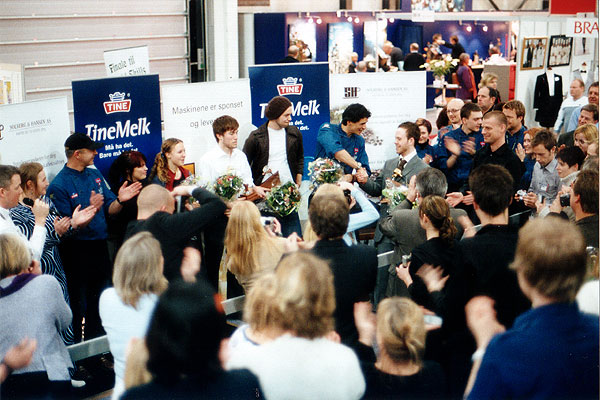Eirik S. Johnsen from Stockfleth’s coffee bar in Oslo represented Norway in the World Barista Championship in Boston this past April, where he placed an amazing third best amongst the world’s top Baristi.
Thomas Gauperaa had a chance to chat with Eirik before the World competition, on an early morning in March just a few hours before his next shift behind the espresso machine. Eirik is only twenty years old, but he is this year’s Norwegian Barista champ and a manager of a coffee bar! This interview was conducted on March 17th, 2003, and all photos are by Thomas Gauperaa, and may not be reused without his permission.
How did you get involved with espresso coffee? How did it all start?
Well, my mom and her sister opened a coffee bar in my hometown Bærum. I got to work there in my spare time. After some time I was sent to Oslo to take a course in espresso brewing at the Norwegian coffee brewing centre. The course was held by 2000 world champ Robert Thoresen.
Thoresen gave a very inspiring and professional introduction to the espresso world, and through both theory and exercises I got an impression of how to do this business correctly. I went back to Bærum and applied what I had learned. Later I got a job at the coffee bar Stockfleth’s in downtown Oslo, and my espresso sensei was to be Tim Wendelboe (Two time Norwegian champ and silver medallist in WBC).
What makes you continue to work as a Barista? Isn’t the job repetitious? Where do you find inspiration?
Sure, 90% of the work is routine, but I try to put every effort into each and every cup I serve. Without that kind of attitude I think I would grow tired pretty fast. My Barista colleagues and the competitions are also sources of motivation.
Which personal qualifications do you think a Barista should have?
A Barista should find pleasure in the daily serving of coffee to customers. It is also important to enjoy the details and precision involved in the work. What we do with the espresso machine isn’t that terribly complex if you look at it as coordinated movements and procedures, and it doesn’t take long to teach somebody how to make espresso and steam milk. It is however possible to take the art a lot further through roasting, blending and so on.
How do you proceed when training a new Barista?
Well, the first week we usually let the apprentice be a backup (“Barback”) to the Barista at work. The apprentice does the cleaning, makes drip coffee and observes the Barista’s technique and movements behind the bar. We also supply self study material about the coffee beans and blends we use, espresso machines, grinders, (David) Schomer’s techniques and so on.
After about a week of cleaning and observing, the apprentice is often anxious to start using the machine and grinder. I usually start by talking about espresso coffee in general, how it differs from normal drip coffee for instance. I then remove the chassis and talk about how the machine works. What really happens when you click the brew button, open the steam valve and so on. This has the effect of removing some of the mystery and makes people more comfortable with the machine.
When we start the actual brewing of espresso shots, I try to keep the rules simple in the beginning, saying for instance that a single espresso is one ounce in 25 secs. As the apprentice progresses we almost imperceptibly let those rules go and let the apprentice start to make more of their own judgments of when to cut the shot and so on. We also send our apprentices to take other courses if possible.
Furthermore, we usually do an alternating routine of letting the apprentice steam milk for a whole day while the experienced Barista brews espresso, and then we change the tasks next day and so on. After a while the experienced Barista can play the role as backup. A small exam ends the training period. It normally takes between three and five weeks before we let a new Barista work in the bar alone.
It seems to me that you put a lot of effort and time into your training program. Do the Baristas stay in the job longer because of this? Isn’t it disappointing when people quit?
Sure, but we ask specifically about this when hiring. We want people working for us for extended periods of time, not just six months for example. We have lots of applicants, but we tend to choose the people with a genuine interest for the craft.
We used to have an age limit of 20 years, but we have since changed our minds. We’ve found that younger people often have a good working spirit and a willingness to learn new things.
(Eirik is a good example, as he is only 20 himself)
Our conversation moves to espresso blends. We talk about their new blend called “Stockfleth’s Espresso”, and about a custom blend that is being made especially for Eriks participation in the forthcoming WBC.
Stockfleth’s Espresso is a blend consisting of Kenya, Colombia, Java and an Indian robusta called Kapi Royal. Espresso made from this blend is sweet, fruity and with some chocolate in the finish. Compared to our old blend it is pretty different, so the Baristas and the roasters are still in the process of adjusting.
I am also working on my own custom blend to be used in the WBC. Its contents are a secret for now. We will probably bring along three different variations to have some way of compensating for the differences in water quality, characteristics and more.
How did it feel to win the Norwegian Barista championship this year?
It was actually a bigger surprise to end up second place last year. I felt pretty confident in having a good chance of winning this year. Still, winning the gold this year was great, and I truly appreciate the recognition from the espresso scene.



Did you face stiff competition?
Yes, my competitors were good, but really the competition is more on the personal level for me and I think it is like that for the others too. I am competing with myself to be able to focus and do my very best under such pressure. My preparations for the contest were really modest, but it didn’t affect my nerves. I think I am lucky to be able to stay calm and confident in what I do.
How do you prepare for the WBC next month (April, 2003)
I haven’t done much yet, but I guess I will try to work on my presentation, and to have a clearer plan on what I should do.

In the Norwegian championship I was kind of only representing myself, but now I’m representing all the other guys who I competed against, as well as the rest of the Norwegian espresso scene. Of course that makes me feel the pressure, as I do want to represent them in a good a manner as possible.
Why do you think we Scandinavians do so well in Barista competitions?
I think it is because we have a somewhat perfectionist culture, at least in Norway. In the last (few) years we have had a big wave of interest for espresso coffee happening here. In many ways we’ve seen a new trend and a new business emerge. When something like that happens it is only natural that some individuals want to compete and do things better than others.
Norway is also one of the big consumers of coffee in the world. It is for the most part drip coffee, but still…
In my opinion, we are already seeing a stronger focus on the product itself, the cup of coffee made by a dedicated Barista. The hip, trendy and symbolic aspects that made people frequent coffee bars before are not that strong anymore.
Maybe the espresso coffee will self-adjust to the better, by people choosing to go to the bars that have the best coffee instead of the coolest vibe and interior?
Yes, I hope so.
Do you have any advice for people wanting to make espresso at home?
First of all, consider thoroughly if this is something you want to do. Good espresso in your own kitchen requires a relatively big investment of money and time, and it will make your kitchen somewhat messy. If you’re confident in this and genuinely interested in learning the craft, go out and buy if possible everything you need at once.
Don’t spend all your money on a Rancilio Silvia only to be depending on your local coffee bar for grinding your coffee. You will be disappointed that the espresso is not what you expected it to be and that you are not in control of the variables. Buy a good espresso grinder and a real tamper. If you don’t do this chances are that your machine will be collecting dust in a cabinet.
Ask your dealer for a quick course in how to use the machine and make the typical drinks. That will save you a lot of trouble and pondering, and you will be making decent espresso and milk based drinks from the get go.
What is the most common mistake that people do when making espresso at home?
Well, many don’t have any impression of what espresso brewing is all about. For instance the fact that water under pressure (will follow) the path of least resistance. That is why correct packing, dosing, et cetera is so important. Everything is much easier if you learn the ground rules and the reasons behind them.
What about the coffee bars? What mistakes do they make?
They often have not made any overall decision of what their coffee product should be. If I get served over-extracted espresso and boiled milk, and it is a conscious choice made by the Barista and owner, then fine I can respect that. I won’t drink it, but I respect it.
What I do see most of the time is coffee drinks being served that are of very variable quality. The cleaning is lacking, the barista has no understanding of what lies behind the espresso coffee making its way from the green bean to the grinded espresso coffee that is packed and brewed. They are just serving generic coffee drinks and not really caring about the end product and the experience their customers get.
Finally, could you please give us the recipe for your signature drink? What is it called by the way?
Sure, but I don’t really have a name for it. Well, the working title was “La Perlita” so I guess I will say that.
La Perlita Signature Drink, by Eirik Johnsen
Ingredients:
Double espresso ristretto
1 part honey
1.5 parts cream
1 part lemon juice
(vary the part for taste)
sugar to taste
Guatemala La Perla Coffee (ground fresh)
Ice cubes
Brew a double espresso ristretto, pour into a martini shaker along with ice cubes and sugar. Add cream, honey and lemon, shake, and pour into champagne glasses. Use a pepper grinder to grind some Guatemala La Perla coffee on the top and serve.
Eirik says about serving the drink in the Norwegian Championships: I used a bit more cream than honey. (The fresh ground coffee) gave the judges an instant aromatic experience when they moved the drink towards their lips. It was a success!























































